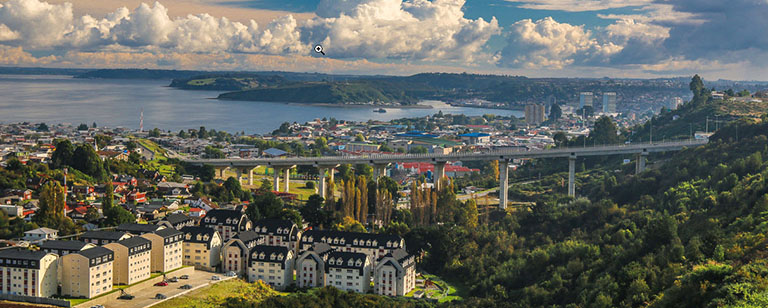|
Our Ship - MARINA
|
Ports
|
Santiago de Chile
|
Puerto Montt, Chile
|
Puerto Chacabuco, Chile
|
Laguna San Rafael, Chile
|
Chilean Fjords
|
Punta Arenas, Chile
|
Ushuaia, Argentina
|
Drake Passage
|
Antarctica
|
Port Stanley, Falkland Islands
|
Puerto Madryn, Argentina
|
Punta Del Este, Uruguay
|
Montevideo, Uruguay
|
Buenos Aires, Argentina
|
Points of Interest
|
Iguazu Falls
|
Resources
|
Books
|
|
|
|
|
|
|
Puerto Montt is a port city and commune in southern Chile, located at the northern end of the Reloncaví Sound in the Llanquihue Province, Los Lagos Region, 1,055 km to the south of the capital, Santiago.
Founded as late as 1853 during the German colonization of southern Chile, Puerto Montt soon outgrew older neighboring cities through its strategic position at the southern end of the Chilean Central Valley being a gateway city into the Chiloé Archipelago, the Llanquihue and Nahuel Huapi lakes and Western Patagonia.
Puerto Montt has gained renown and grown significantly through the rise of Chile to become the second largest salmon producer of the world during the 1990s and 2000s. The city's cultural endowment mixes elements of Chiloé culture with a German heritage. The city has attracted a significant number of newcomers from all over Chile in the last 30 years in search of employment opportunities.
In 1912 the city was connected by train to Santiago, making it an important point of entry into Chilean Patagonia and augmenting its commercial development. By 1950 it had a population of 27,500, and the city was rapidly urbanizing. However, the 1960 Valdivia earthquake destroyed much of Puerto Montt, collapsing the port and the train station along with many building and houses. Eventually the city recovered, becoming once again an important urban centre as well as a port of national interest
According to the 2017 census, Puerto Montt has 245,902 inhabitants. Of the overall population, 52,483 belong to indigenous groups, with 50,247 being Mapuche, 314 Aymara people, 73 Rapa Nui people, 19 Lican Antai, 84 Quechua people, 27 Colla, 136 Diaguita, 114 Kawésqar, 38 Yahgan, 175 other and 1,256 declaring indigenous status but not identifying a group.
Puerto Montt has a wet oceanic climate with heavy rainfall throughout the year but a drying trend in the summer. Although temperatures are consistently below 25 °C (77 °F), frosts are very rare and occur only a couple of times per month in the winter.
The city is configured as the hub of one of the largest salmon aquaculture industries in the world. Hatcheries, fisheries and packing plants are mostly located south of Puerto Montt. Fresh salmon is flown daily to world markets and frozen salmon is shipped by ocean to all destinations. The tremendous growth of the region, mainly due to the salmon industry, but also due to rapid expansion of forestry, cattle, and tourism, has proven the massive economic potential of Puerto Montt and its surrounding area.
| |
Cruise Port What's in Port Cruise and Sea What to Know Before You Go
| |
Links The Top Things to See and Do in Puerto Montt Top Attractions Puerto Montt | |
Tours Chile Dream Tours - Puerto Montt
TripAdvisor - Puerto Montt
Get Your Guide - Puerto Montt
Chile Shore Excursions - Puerto Montt
| |
| |
| |
| |
|
